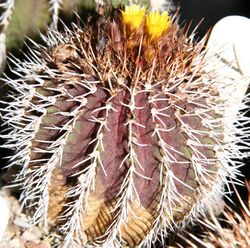Biology:Uebelmannia buiningii
| Uebelmannia buiningii | |
|---|---|

| |
| Scientific classification | |
| Kingdom: | Plantae |
| Clade: | Tracheophytes |
| Clade: | Angiosperms |
| Clade: | Eudicots |
| Order: | Caryophyllales |
| Family: | Cactaceae |
| Subfamily: | Cactoideae |
| Genus: | Uebelmannia |
| Species: | U. buiningii
|
| Binomial name | |
| Uebelmannia buiningii Donald
| |
Uebelmannia buiningii is a species of plant in the family Cactaceae. It is endemic to Brazil . Its natural habitat is dry savanna. It is threatened by habitat loss.
Description
Uebelmannia buiningii grows with greenish to reddish brown, spherical to short cylindrical bodies that reach diameters of up to 8 centimeters. The epidermis is rough due to wax deposits. The 18 straight ribs are spaced 15 millimeters apart. They are divided into about 5 millimeters distant downward cusps. The areoles are covered with a little wool. The 4 middle spines are crossed. The 2 to 4 straight edge spines are up to 5 mm long and shorter than the middle spines.
The yellow flowers are up to 2.7 inches long and reach a diameter of 2 centimeters. The egg-shaped fruits are yellow and have diameters of up to 4 millimeters.[3]
Distribution
Uebelmannia buiningii is widespread in the Brazil ian state of Minas Gerais in the Serra Negra and grows on quartz grit.
Taxonomy
The first description was made in 1968 by John Donald Donald. The specific epithet buiningii honors the Dutch cactus lover and specialist in Brazilian cacti Albert Frederik Hendrik Buining.
References
- ↑ Machado, M.; Braun, P.; Taylor, N.P. (2013). "Uebelmannia buiningii". IUCN Red List of Threatened Species 2013: e.T40949A2946413. doi:10.2305/IUCN.UK.2013-1.RLTS.T40949A2946413.en. https://www.iucnredlist.org/species/40949/2946413. Retrieved 14 November 2021.
- ↑ "Appendices | CITES". https://cites.org/eng/app/appendices.php.
- ↑ Anderson, Edward F.; Eggli, Urs; Anderson, Edward F. (2005) (in de). Das große Kakteen-Lexikon. Stuttgart (Hohenheim): Ulmer. p. 637. ISBN 3-8001-4573-1.
External links
Wikidata ☰ Q290632 entry
 |


